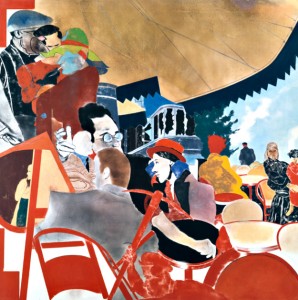Kitaj’s canvasses are riddled with references to artists and scholars, from Erasmus to Herman Melville, from Fra Angelico to Rosa Luxemburg. From a formal perspective, Kitaj’s obsessive use of citations reflects on the visual impact of images and names, signs and references. Conceptually, citations can involve finding artistic forefathers, and building an intellectual community. This is what I find particularly moving about Kitaj’s work: the artist peoples his paintings, like dream worlds, with “adopted ancestors,” who interact with one-another. This seems to be telling of the Jewish experience in post-Holocaust Europe: Another Jewish artist working in Europe, the Jewish Museum’s architect Daniel Libeskind, also pays tribute to a large number of scholars and artists, and coincidentally, to many of the same as Kitaj: The museum’s courtyard is dedicated to Paul Celan (whom Kitaj sketched, above), its Sackler Staircase to Walter Benjamin (whom Kitaj honored in a painting). In this exhibition, the canvasses respond to their walls in a more intimate way than usual.
Naomi Lubrich, Media
